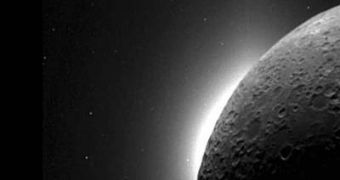“Earthshine” is a relatively unknown phenomenon that astronomers have observed on the surface of the Moon. Simply put, it is our planet's reflection on the lunar surface, in that light bouncing off our “home” reaches and illuminates the surface of our natural satellite. The Clementine spacecraft, officially named Deep Space Program Science Experiment (DSPSE), a joint collaboration between the Ballistic Missile Defense Organization and NASA, brought back photographic evidence of this occurrence, when it pictured the Moon lit by the Earth, with the Sun behind the satellite, giving it a very beautiful glow.
“In the future, astronomers hope to find planets like the Earth around other stars. However, these planets will be too small to allow an image to be made of their surface. We can use earthshine, together with our knowledge of the Earth's surface to help interpret the physical makeup of new planets. If we find Earth-sized planets and watch their brightness as they rotate, we will be able to assess properties like the existence of land and oceans,” University of Melbourne physics graduate student Sally Langford is quoted as saying by Space.
She explains that this trait may be one exhibited by numerous planets able to support life, which can be detected by the newly launched Kepler telescope. The main goal of the observatory is to hunt for Earth-like planets, and the researcher adds that earthshine may be one way of assessing if a very distant planet is able to sustain life somewhere on its surface. “When we observe earthshine from the moon in the early evening, we see the bright reflection from the Indian Ocean, then as the Earth rotates, the continent of Africa blocks this reflection, and the moon becomes darker,” she explains, referring to the fact that future observations on other planets may only yield conclusive results if long-term studies are carried out.
When analyzing the brightness reflection of a planet, she continues, researchers could find out if that exoplanet contains oceans, and, furthermore, if land is also available. One way of doing this is to analyze variations in the perceived reflection that this celestial body gives out. The procedure is very similar to that used to discover the exoplanets themselves, when variations in the luminosity of a star are an indicator that something like a planet or a moon has passed between it and the observer peering at the star.

 14 DAY TRIAL //
14 DAY TRIAL //